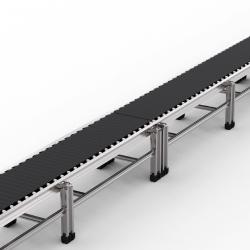Conveyor belt systems play an indispensable role in the world of logistics and distribution. These automated systems are the unsung heroes behind the smooth flow of goods in various industries, ensuring timely deliveries, reduced labor costs, and increased efficiency. In this detailed guide, we will explore the critical role conveyor belt systems play in logistics and distribution, their types, benefits, maintenance, and future innovations.
Types of Conveyor Belt Systems
-
Belt Conveyors: Belt conveyors consist of a continuous loop of material that rotates around two or more pulleys. They are highly versatile and used for transporting a wide range of products, from small packages to heavy loads.
-
Roller Conveyors: Roller conveyors use rollers to move materials. They are excellent for handling pallets and large items efficiently.
-
Slat Conveyors: Slat conveyors use slats or plates made of various materials to carry items. They are ideal for transporting hot, oily, or abrasive materials.
-
Overhead Conveyors: Overhead conveyors are suspended from the ceiling and are commonly used in paint lines, garment handling, and automotive assembly lines.
-
Screw Conveyors: Screw conveyors use a helical screw blade to move bulk materials. They are commonly used in agriculture and food processing industries.
Benefits of Conveyor Belt Systems in Logistics and Distribution
-
Increased Efficiency: Conveyor belt systems can move products continuously, eliminating the need for manual labor in material handling. This leads to increased efficiency, faster production, and reduced labor costs.
-
Space Optimization: Conveyor systems can be designed to fit the available space in a facility, allowing for better space utilization compared to traditional methods of transportation, such as forklifts.
-
Consistency and Precision: Conveyor systems ensure consistent and precise movement of goods, reducing the risk of errors and damage during transportation.
-
Reduced Labor Costs: Automation provided by conveyor belt systems significantly reduces the need for manual labor, leading to cost savings and a safer work environment.
-
Improved Safety: Conveyor systems are equipped with safety features such as emergency stops and sensors that help prevent accidents and injuries.
Maintenance and Care
To keep conveyor belt systems operating at peak efficiency, regular maintenance is essential. Here are some key maintenance tasks:
-
Cleaning: Regularly clean the conveyor belts and components to remove debris, dirt, and spillages that can cause jams or damage.
-
Belt Inspection: Inspect belts for signs of wear, tears, or damage. Replace worn or damaged belts promptly to prevent disruptions.
-
Lubrication: Properly lubricate moving parts to reduce friction and extend the life of components.
-
Tension Adjustment: Ensure that the belt is correctly tensioned to prevent slippage and maintain efficient operation.
-
Regular Inspections: Conduct routine inspections of the entire system to identify and address issues before they lead to downtime.
Future Innovations in Conveyor Belt Systems
The world of logistics and distribution is continually evolving, and conveyor belt systems are no exception. Here are some future innovations to watch for:
-
Smart Conveyor Systems: Integration with Internet of Things (IoT) technology to enable real-time monitoring, predictive maintenance, and data-driven decision-making.
-
Modular and Flexible Design: Conveyor systems that can be easily reconfigured or expanded to adapt to changing production needs.
-
Energy Efficiency: More energy-efficient conveyor systems designed to reduce the environmental footprint of logistics and distribution operations.
-
Autonomous Conveyor Systems: Development of autonomous conveyor systems that can self-optimize their routes and adapt to changing conditions.
Conclusion
Conveyor belt systems are indeed key players in logistics and distribution, revolutionizing the way goods are moved within facilities. Their ability to enhance efficiency, reduce labor costs, and improve safety makes them an essential component in modern industrial operations. By understanding the different types of conveyor systems, their benefits, maintenance requirements, and future innovations, businesses can harness the full potential of conveyor belt systems to optimize their logistics and distribution processes.
